In our May Newsletter we reported on a visit to Jekka's Herbs to see small scale pot herb production for specialist markets. VHB Herbs, which we report on below, is by contrast very much a large scale producer of both pot and cut herbs for major supermarkets. Thanks to Production Director, Chris Moncrieff for hosting a committee meeting and showing us around the nursery.
David Miller Travel Bursary
We must also thank Chris Moncrieff and VHB Herbs for sponsoring the David
Miller Travel Bursary Awards. This sponsorship together with a grant from
SCI enabled us to make two awards this year. They went to:
- Emma Bennett from Reading University to further her studies on plant senescence by attending the Gordon Research Conference on Plant Senescence in Massachusetts, USA, and to then travel on to the Genomics Center at the University of California Davis.
- Scott Hayes from Bristol University to further his studies on shade avoidance by attending the Frontiers and Techniques in Plant Science course at the Cold Spring Harbour Laboratory in the USA.
We will be reporting on their visits in a later edition.
Annual General Meeting
The Annual General Meeting of the Group will be held at 2.00pm on Friday 21
September at Belgrave Square. All members will be welcome. We hope that both
Emma Bennett and Scott Hayes will be able to attend and give short presentations
Basil, thyme and herbs by the hectare
We were welcomed to VHB Herbs Runcton Nursery near Chichester in West Sussex by Production Director, Chris Moncrieff. He explained that herb growing had started as a small unit at Van Heyningen Brothers (VHB) West End Nursery along the coast at Angmering. The business had grown to gradually take over the West End Nursery and then expand further into the Runcton Nursery providing the company with eight hectares of production space.
In the meantime VHB, after a period as part of Hazlewoods Foods had merged with Humber Growers to form Humber VHB. This company then broke up and VHB Herbs now forms part of the UK Vitacress Group, which in turn is part of the Portuguese RAR Group. The latter is a somewhat eclectic group including aerosols, sugar, chocolate and travel as well as Vitacress.
VHB Herbs now produces around 50,000 pots per day along with its cut herb production and turns over £32m. The current business is roughly 50% pot herbs grown in Sussex and 50% cut herbs which are largely imported. The cut herb side of the business has expanded recently as the company believed it needed a strong presence in both sectors. Although it has competition in the UK, transport and retailing costs have so far limited competition from abroad in pot herbs and to date it maintains a sizeable share of the cut herb market.
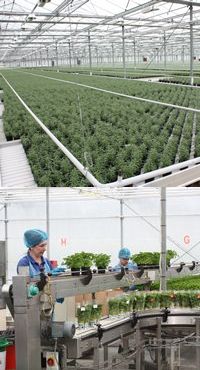
Basil accounts for 35% of production, coriander 22% while flat and curly-leaved parsley account for 20%. Once the seeds are sown or the cuttings rooted the benches are moved out into the growing area (picture upper right) where they remain for around 35 days before being ready for sale. Each bench carries a unique number, so it can be tracked both by location and stage of development.
The benches then return to the 'processing' area where they are checked, bagged, and boxed, ready for delivery to customers (picture lower right). Any oversupply from the pot plants can be harvested as cut herbs, which reduces the need to buy in.
We then moved on to the packhouse where the cut herbs are prepared and packed. This has been created by insulating part of the existing greenhouse. Here temperature and humidity control is vital to preserve the freshness of the product. Newly arrived herbs are stored and quality checked at 3°C, an unenviable job. They then move to one of six packing lines at around 10°C to be weighed and sealed into pillow packs, before being boxed ready for delivery.
Quality control is vital through all operations but particularly vital in the packhouse. One end of the packhouse is devoted to a wall of paper, monitoring each batch as it goes through, as well as the performance of the staff.
Plant of the Month
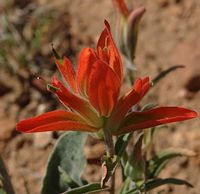
This hemi-parasite from south western states of America (Arizona, Colorado, New Mexico and Texas) has leafy stems and a woody root. Its leaves are not incised or lobed as many of the other species of paintbrush are, hence the species name 'integra'. The genus name commemorates an 18th century botanist. Domingo Castillejo, of Cadiz, Spain. This beautiful plant is a native of arid hills, plains and mesas and will bloom throughout the summer months. Its roots grow until they touch the roots of other plants (frequently grasses), then penetrate the roots of host plants to obtain a portion of its nutrients.
Previously classified in the Scrophulariaceae, it has been moved to the Orobanchaceae. Nearly all members of this family are either hemiparasitic or holoparasitic.
It can be seen in flower now on the new Merton Borders at the University of Oxford Botanic Garden.
Alison Foster
Oxford Botanic
Garden
Medicinal Plant of the Month
Hordeum vulgare, barley, poaceae
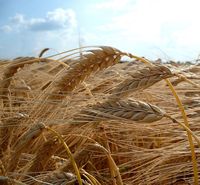
Barley (Hordeum vulgare pictured right) has associations with pain relief. In the 1930s, Nobel Prize winner Hans von Euler wanted to investigate how genes and enzymes are chemically related. He obtained some mutant barley plants and looked for chemical differences between the normal and mutant plants. From the mutant plants he isolated a substance called gramine. The same substance was isolated in 1935 by Russian scientists from Arundo donax.
They claimed to be investigating this plant because camels refuse to eat it! A molecular structure was proposed on the basis of the recorded mass of the substance. In the 1930s the advanced spectroscopic instrumentation that we have available today did not exist and so in order to confirm the structure a synthesis was undertaken. Once the task was complete the chemist did what he always did to a new product - he dipped his finger in and then tasted a small amount on his tongue!
This substance caused a mild numbing sensation. Unfortunately it turned out not to be gramine, but a structural isomer of the natural product and was named iso-gramine. It did however prove to be the starting point of a drug discovery programme that eventually led to the synthesis of LL30 in 1943. This compound was licensed to the Swedish pharmaceutical company Astra and given the proprietary name Xylocaine, now commonly known as lidocaine or lignocaine and which is still today used as a local anaesthetic in dentistry and for haemorrhoids. Lidocaine has also been used as an anti- arrhythmic drug particularly after heart attacks.
Alison Foster
Oxford Botanic
Garden
Horticulture Industry News
For the very latest horticultural news follow us on Facebook and or
Twitter.
Researchers show how probiotics boost plant immunity
A scientific team found that when pathogens attempt to invade a plant through
the stomata in its leaves, a surprising ally comes to the rescue. Soil bacteria
at the plant's roots signal the leaf pores to close, thwarting infection.
The fascinating defence response is documented in video and micrographs of
live plants taken by confocal and scanning electron microscopes at the Delaware
Biotechnology Institute. The research explored the interaction between the
soil bacterium Bacillus subtilis and the laboratory plant Arabidopsis
thaliana. The findings underscore both the importance of root-based processes
in plant defence and the potential for bolstering plant immunity naturally
through the emerging field of probiotics. More
Why peppers do not mature after picking
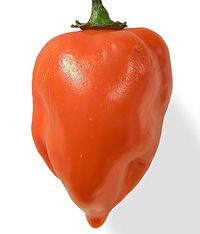
These are called ACC synthase and ACC oxidase. During the ripening process, climacteric tomato fruits produce much more of these enzymes, which causes ethylene levels to rise continuously. The ethylene then sets a cascade of signals in motion in the tomatoes, causing the fruits to ripen. Green chloroplasts convert to colourful chromoplasts, the hard cell wall components break down, sugars are formed and the nutrient content changes. This is not the case with the chillies. Ethylene has no influence on the gene expression or the metabolism of habenero chilli peppers.
Surprisingly, though, genes lower down the ethylene signal chain showed heightened levels of activity. Genes for breaking down the plant cell wall or the carotenoid biosynthesis during the plant's normal process of ripening were produced in greater quantities in the tomatoes and peppers alike. More
New headquarters for AKP Group
Elsham Wold has just become the new headquarters for Arundel Kerr Produce
Ltd (AKP Group), potato supplier to supermarket giant Morrisons and major
chip manufacturer McCain. A £3m state-of-the-art office block,
temperature controlled potato storage facility and grading line, together
with extensions to existing handling areas have just been completed.
Understanding wood formation
Scientists at North Carolina State University found that one member of a family
of proteins called transcription factors took control of a cascade of genes
involved in forming wood, which included the lignin that binds fibres together
and gives wood its strength. The controller protein regulated gene expression
on multiple levels, preventing abnormal or stunted plant growth. And it did
so in a novel way. The controller, a spliced variant of the SND1 family, was
found in the cytoplasm outside the cell nucleus.
This is abnormal, because transcription factor proteins are always in the nucleus. But when one of the four other proteins in its family group was present, the spliced variant was carried into the nucleus, where it bound to the family member, creating a new type of molecule that suppressed the expression of a cascade of genes. 'This is nothing that's been observed before in plants,' says Dr Vincent Chiang, co-director of NC State's Forest Biotechnology Group with Dr Ron Sederoff. Chiang's research team was the first to produce a transgenic tree with reduced lignin. High lignin levels are desirable for lumber, but lignin is removed during the process of making paper or manufacturing biofuels. More
Highland Heathers goes into receivership
Plant nursery Highland Heathers Ltd has been placed into receivership which
will result in 43 people losing their jobs. The family-owned wholesale nursery,
based in Ford, near Lochgilphead, operates across four sites in Argyll, supplying
more than two million plants to independent garden centres and landscapers
throughout the UK. The company was established in 1978 and generates sales
of around £2m a year. However the business struggled this year
as a result of poor weather, rising overhead costs, falling consumer demand
and an increase in foreign competition.
Sniffing when plants are under attack
The smell of freshly-cut grass may stir memories but what we perceive as a
sweet aroma is actually the plant equivalent of a distress call, one that
the grass releases to signal that the lawn is under attack. The same thing
happens frequently in vegetation all around us, but it goes unnoticed because
humans normally don't have the ability to smell or see the special compounds
called green leaf volatiles that plant species emit when they are damaged
by pests or disease.
Now scientists are developing a chemical sensor to detect these odourless, invisible volatiles that foretell plant distress well before they show signs of disease or trauma. The sensor has a variety of potential applications, but they hope this work will have its greatest impact on farms and food storage facilities. Rather than spray entire fields with expensive chemicals as a preventive measure, Ramasamy hopes that farmers could rely on sensors that identify specific sectors of a field that are under stress. More
CIWEM urges urgent action on phosphorus...
Urgent action is needed to reduce the rate of phosphorus depletion said The
Chartered Institution of Water and Environmental Management (CIWEM) in its
latest policy statement. The statement outlines the main issues relating to
the world's supply of useable phosphate and highlights the need for
urgent action to achieve its recovery to improve food security and reduce
geopolitical risk. We rely on the mining of inorganic phosphates for agriculture
and industry.
This would not be an issue if there were abundant supplies, but that is far from the case. At the present rate of extraction, today's phosphate mines will be exhausted by the end of the 21st century and estimates of future reserves range from 200 to 400 years (at the current rate of extraction). China and the USA have both tried to implement measures to reduce exports of phosphate as they have already realised its strategic importance. More
... But solutions are being developed
A professor at Michigan State University is part of a team developing a new
method of removing phosphorus from wastewater. In addition, workers at Columbus,
Ohio, based-MetaMateria Technologies, are devising a cost-effective way of
recovering the phosphorus, which then can be reused for fertiliser products.
What MetaMateria Technologies and Safferman have figured out and tested over the past 10 years is how to produce a medium, enhanced with nanoparticles composed of iron, that can more efficiently remove larger amounts of phosphorus from water. Safferman found that nano-media made with waste iron can efficiently absorb phosphorus, making it a solid that can be easily and efficiently removed and recovered for beneficial reuse. More
RBGE unveils masterplan
The Royal Botanic Garden Edinburgh (RBGE) has announced details of its planned
£40m (approx) Masterplan development project, following the release
of a £1.5m grant from the Scottish Government. This money will be used
for early completion of some essential elements of a much larger-scale project.
At present, it is thought that this enabling work will include some refurbishment work, to include the damaged glasshouses along with construction of a 'decanting' facility which will be used as a temporary location for some of the living collection during later development works, and will provide a legacy space for future use. These smaller projects lead into the RBGE 'Masterplan', to redevelop the north east quarter of the Edinburgh Garden, encompassing five key areas of RBGE's work.
Reduce reliance on pesticides and fertilisers
The findings of an international plant study, involving Queensland scientists,
may help to end agricultural reliance on high pesticide and fertiliser application.
The study sheds light on how microbial communities (microbiomes) living in
and on plant roots can boost plant health, growth and defence against pests.
The research studied the microbiome in soil around the roots of more than 600 Arabidopsis thaliana plants. The team investigated how the microbiome helps shuttle nutrients and information into and out of the roots within the soil matrix. The findings suggest that high resolution knowledge of the plant root microbiome could help develop a strategy of community-based plant probiotics to augment or even replace fertilisers and pesticides and improve plant health. More
Exports increase at Berry Gardens
'This year the British soft fruit season has been the most volatile that
I can ever recall,' reported Nicholas Marston, Managing Director of Berry
Gardens Ltd, at Fruit Focus at East Malling Research, Kent. According to Mr
Marston, the latest Kantar Worldpanel data shows that the UK strawberry market
grew modestly in the past year: 2.4% by value and 4.4% by volume. In order
to help move the excess volumes of fruit this year Berry Gardens has exported
more than it has historically. More
New technology eliminates plant toxins
Plants produce toxins to defend themselves against potential enemies, from
herbivorous pests to diseases. Oilseed rape plants produce glucosinolates
to serve this purpose. However, due to the content of glucosinolates, farmers
can only use limited quantities of the protein-rich rapeseed for pig and chicken
feed.
Now, a team of researchers from the University of Copenhagen has developed a method to hinder unwanted toxins from entering the edible parts of the plant. Researchers have now identified two proteins that transport glucosinolates into the seeds of Arabidopsis, a close relative of the oilseed rape. When they subsequently produced Arabidopsis without these two proteins, their seeds were completely free of glucosinolates and thus suitable for feed. More
New herb product launched
VHB Herbs has launched a new concept for the fresh herb retail
category. The new range called Fresher for Longer, is a 'roots on'
selection of fresh herbs and is the first format of its kind for a UK supermarket.
Launched in selected Tesco stores it consists of four types of herbs: basil,
coriander, flat leaf parsley and dill. The herbs are harvested with the root
plug intact, providing a fresh herb ready to cut. Developed in partnership
with nursery Madestein UK, the new format is designed to offer maximum freshness
and convenience for consumers.
UK national action plan for the sustainable use of pesticides
DEFRA has launched a consultation that invites views on the draft UK National
Action Plan (NAP) for pesticides. This is the next stage in the implementation
of the EU Directive on the sustainable use of pesticides which was transposed
into UK law on 18 July by the Plant Protection Products (Sustainable Use)
Regulations 2012. The National Action Plan (NAP) is designed to ensure that
plant protection products can be used sustainably in the UK and is to be developed
in consultation with stakeholders including members of the public. More
Plants choose soil bacteria that they allow into their roots
Researchers from the Max Planck Institute for Plant Breeding Research in Cologne
and the Max Planck Institute for Marine Microbiology in Bremen have discovered
that the model plant Arabidopsis preferentially takes up three bacterial
phyla into its roots: Actinobacteria, Proteobacteria and Bacteroidetes. This
community of microbes is dependent on soil type and plant genotype. A census
was carried out of the bacterial populations in the Arabidopsis root
and identified varying quantities of 43 bacterial phyla. It is concluded that
Arabidopsis makes a selection of the inhabitants of its roots from the profusion
of microorganisms in the soil. More
Wasabi diversification for Watercress Company
The Watercress Company has diversified into growing wasabi (Wasabia japonica)
saying it is the first European commercial grower of the rhizomes, usually
used in paste form in Japanese cuisine. Managing director Tom Amery said:
'Wasabi is a very different type of product to watercress, but it, too, is brimming
with compounds and is already known to have medicinal benefits.'
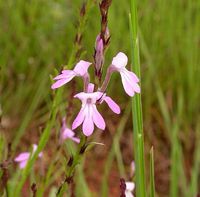
The
obligate parasitic plant, Striga causes estimated global annual losses of US$7bn and adversely
affects food security for more than 100m people mostly in sub-Saharan Africa;
in fact there is a near perfect overlap between areas of Striga infestation
and subsistence agriculture where hunger prevails.
So researchers in the UK, India and Africa have been collaborating through the SARID programme to develop research capabilities in Africa and use new methods to look for Striga-resistant varieties of crops. They identified where on the rice chromosomes the Striga resistance genes are located, so that these genes can be transferred, via marker assisted breeding programmes, into high yielding varieties that the farmers want to grow.
eEvents Calendar
Amenity
Arboriculture Conference
2 - 5 Sep, Arboricutural Association
Reading, UK
Ornamental
Breeding Worldwide
2 - 5 Sep, International Society for Horticultural Science
Warsaw, Poland
Physics
meets Biology
3 - 5 Sep, Society of Biology
Oxford, UK
Four Oaks
Trade Show
4 - 5 Sep
Lower Withington, UK
Saltex
4 - 6 Sep, Institute of Groundsmanship
Windsor, UK
International
Chestnut Symposium
4 - 8 Sep, International Society for Horticultural Science
Shepherdstown, USA
International People
Plant Symposium
6 - 8 Sep, International Society for Horticultural Science
Venlo, The Netherlands
International
Humulus Symposium
9 - 14 Sep, International Society for Horticultural Science
Zatec, Czech Republic
European Microscopy
Congress
16 - 21 Sep, European Microscopy Society
Manchester, UK
GLEE
17 - 19 Sep, i2i Events Group
Birmingham, UK
Postharvest Research,
Education, and Extension
18 - 20 Sep, International Society for Horticultural Science
Bogor, Indonesia
Natural
Products and Biocontrol
19 - 21 Sep, International Biocontrol Manufacturers Association
Perpignan, France
Biological Plant
Protection as the Basis of Agricultural Ecosystem Stabilization
25 - 27 Sep,
Krasnodar, Russia
Olive Growing
25 - 29 Sep, International Society for Horticultural Science
San Juan, Argentina
Macfruit
26 - 28 Sep, Cesena Fiera
Cesena, Italy
South West Growers Show
3 Oct, South West Growers
Exeter, UK
Precision
Farming for Crop Protection
3 Oct, Association of Applied Biologists
Harper Adams, UK
Biopesticide
Market Opportunities
5 Oct, University of Greenwich and Natural Resources Institute
Greenwich, UK
Integrated
Fruit Production
7 - 12 Oct, International Organisation for Biological and
Integrated Control of Noxious Animals and Plants
Kusadasi, Turkey
Acrylamide,
furans and other food-borne contaminants
8 - 9 Oct, Association of Applied Biologists
Munich, Germany
Above
Ground - Below Ground Interactions
8 - 10 Oct, British Ecological Society, Biochemical Society
and Society for Experimental Biology
London, UK
BPOA
Growers Look Ahead
11 Oct, British Protected Ornamentals Association
Stoneleigh, UK
Medicinal
and Nutraceutical Plants
14 - 19 Oct, International Society for Horticultural Science
Aracaju, Brazil
Light in Horticultural
Systems
15 - 18 Oct, International Society for Horticultural Science
Wageningen, The Netherland
Advances
in Biological Control and IPM
16 - 19 Oct, Association of Applied Biologists
Marston, UK
Postharvest Quality
of Ornamental Plants
16 - 19 Oct, International Society for Horticultural Science
Porto de Galinhas, Brazil
Vegetables and Greens
16 - 20 Oct, International Society for Horticultural Science
Yerevan, Armenia
National
Fruit Show
17 - 18 Oct, Marden Fruit Show Society
Marden, UK
International
Symposium on Persimmon
20 - 26 Oct, International Society for Horticultural Science
Guilin City, China
Annual Biocontrol
Industry Meeting
22 - 24 Oct, International Biocontrol Manufacturers Association
Lucerne, Switzerland
Saffron
Biology and Technology
22 - 24 Oct, International Biocontrol Manufacturers Association
Srinagar, India
BCPCWeed Review
24 Oct, British Crop Protection Council
Peterborough, UK
Horti Fair
30 Oct - 2 Nov
Amsterdam, The Netherlands
CropWorld Global
6 - 8 Nov, British Crop Protection Council
London, UK
Human Health Effects
of Fruits and Vegetables
6 - 10 Nov, International Society for Horticultural Science
Dharwad, India
Brassica
12 - 16 Nov, International Society for Horticultural Science
Catania, Italy
Soil &
Water Live
13 Nov, Royal Agricultural Society of England
Stoneleigh, UK
Scientific Horticulture
13 - 14 Nov, Slovak University of Agriculture
Nitra, Slovakia
Interpoma
15 - 17 Nov, Fiera Bolzano
Bolzano, Italy
Biomolecular
Thermodynamics
16 - 17 Nov, Institute of Physics Biological Physics Group
London, UK
Citrus
Congress
18 - 23 Nov, International Society for Horticultural Science
Valencia, Spain
Biostimulants
26 - 29 Nov, International Society for Horticultural Science
Strasbourg, France
Crop
Protection in Southern Britain
27 Nov, Association of Applied Biologists
Peterborough, UK
Lychee, Longan and
Other Sapindaceae Fruits
2 - 7 Dec, International Society for Horticultural Science
White River, South Africa
Integrating
Canopy, Rootstock and Environmental Physiology in Orchard Systems
3 - 6 Dec, International Society for Horticultural Science
Stellenbosch, South Africa
Medicinal Plants
and Natural Products
3 - 6 Dec, International Society for Horticultural Science
Quito, Ecuador
Crop
Genomes and Crop Improvement
5 - 6 Dec, Association of Applied Biologists
Norwich, UK
Good
Agricultural Practices (GAP) for Greenhouse Vegetable Production in the
Mediterranean Region
9 - 12 Dec, International Society for Horticultural Science
Baqa', Jordan
If you would like to advertise a forthcoming event please contact charne.green@soci.org
Horticulture Group Contact Details
For submitting ideas or to volunteer to be part of a committee or a group, please contact:
Chairman - Peter Grimbly
Meetings Secretary - Alison Foster
Minutes Secretary - Margaret Waddy
Newsletter co-ordinator - Sue Grimbly scihortigroup@btinternet.com
Group Contact - Charne Green charne.green@soci.org T: +44 (0)20 7598 1594

